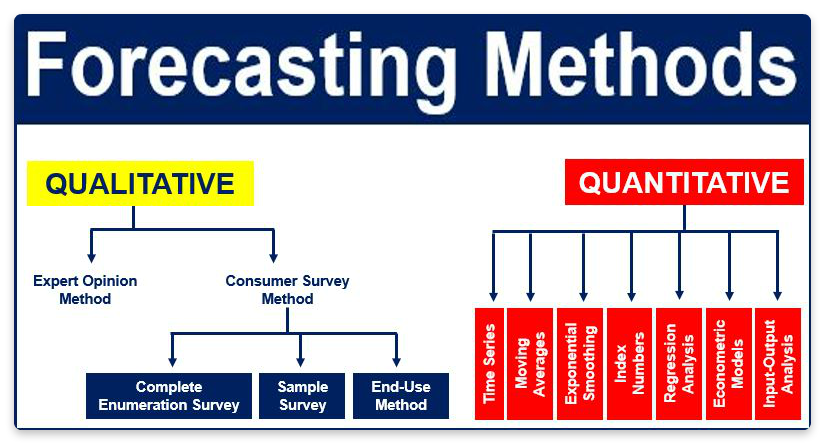Forecasting
Forecasting is a part of the sales and market analysis that helps predict future sales, trends, numbers, and characteristics in the target market. Any kind of business needs to be planned carefully. It is necessary to see the tendencies and react to any changes in time. Forecasting is one of the most effective planning methods. It helps cope with market changes and create an appropriate strategy.
Forecasting relies on the gathered data – usually collected from both the past and the present, followed by the analysis of the market trends and the development of the description of the actions to follow.
Forecasters are responsible for the actual analytical results based on a set of variables, preparing reports that are then used by the marketers for marketing strategy development in the next quarter/month/year. Besides the existing data, forecasting leans on three pillars:
- experience of management
- experts’ knowledge
- judgment
Forecasting and backcasting – what is the difference?
Forecasting uses different techniques and is often paired with one more planning method – backcasting. As can be obvious from the name, backcasting is the forecasting process in reverse: if forecasting is a prediction based on the past and present showings, backcasting is performed by setting a future outcome. Backcasters define the hoped-for result (statistics, sales, conversion, etc.) and then marketers analyze the actual scores.
The third planning method that is used by the analysts and marketers is scenarios. It’s easier to see the difference between all the three prediction methods with the help of the illustration presented below.

(based on data by Researchgate)
To sum up, the 3 main predictive planning methods are:
- Forecasting – prediction of future showings, results, and statistics based on the past and present-day scores.
- Scenarios – prediction of the alternative future. Analysts and marketers try to take into account each pace of development.
- Backcasting – prediction of the hoped-for results and their comparison with the real scores after a certain lapse of time.
Experts name forecasting the most efficient planning tool that can bring actual strategies and better scores to your marketing in the future. And it is necessary to take into consideration all typed of forecasting.
Types of forecasting – quantitative and qualitative prediction techniques
Two main forecasting approaches are qualitative and quantitative. The qualitative method is based on expert opinions and the comprehensive analytical research of consumers’ behavior. The quantitative method is built on the concept of past statistics research.
Marketers consider a complex forecasting technique as the most effective one, which means that both qualitative and quantitative prediction methods should bring actual results that will be used for strategy creation. Forecasters usually take into consideration the following aspects:
- expert evidence
- consumer surveys
- regression & input-output analysis
- moving averages, econometric models, etc.
All existing forecasting methods are presented in the table below.

Forecasting for lead generation
Marketers always aspire to find the best digital marketing tactics. That is why forecasting for lead generation has become popular is now widely used.
Besides the analytical tools that can be implemented for quantitative forecasting methods, it is recommended to also focus on the following aspects:
- Lead generation is closely related to the company deals and their size.
The head of the project needs to determine the average deal size to make the lead generation prediction correctly. Knowing the desirable deal size, forecasters can run the analytical research and provide marketers with the predicted quantity of total leads, MQL (market qualified leads), SQL (sales qualified leads) and clients. - The second stage of forecasting in lead generation is the allocation of spendings.
Marketers need to know beforehand the cost of an efficient conversion. Forecasters take into consideration the historical rates and provide the predicted spendings. It should be noted that lead forecasts might change and the predictions can and should be performed repeatedly. - The final stage is the marketing tactic development.
Note that lead generation requires the implementation of multiple tactics at the same time. Forecasters and marketers must work together to develop an actual plan for the future lead generation process that takes into account company development.
One more scope of digital marketing activity where predictions play a key role is email marketing.
Forecasting in email marketing
Sales forecasting is one of the most in-demand prediction methods for email marketers.
It is necessary to divide all email stats that form unique sales statistics into separate groups (all the items here are placed in the order of importance, from least to most):
- Emails sent
- Emails opened
- Email clicks
- Website views
- Viewed conversion rate
- Sales
Email sales forecasting should be based on the past and present-day scores. In general, the more email letters are sent, the more email sales there are. So if, for example, marketers send about 30,000 messages per month now and get 50 unit sales, it can be predicted that 50,000-mailout will bring 70 unit sales.
Forecasting is an effective planning tool for digital marketing that helps achieve enhanced management, more targeted marketing and higher sales.















